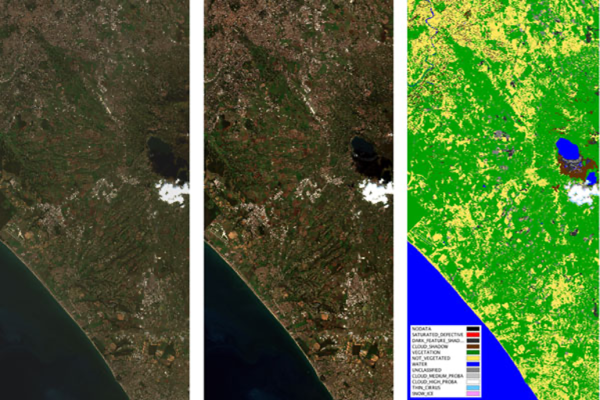The Sentinel-2 Level-2A pre-Collection-1 represents the products dataset generated up to processing baseline 03.01 included.
The evolutions of the processing baseline (PB) are tracked and justified in the 'Processing Baseline Status' section of the Data Quality Report that is published on a monthly basis by the Mission Performance Center (MPC), available from the Sentinel-2 Document Library and described in Table 1.
| Processing Version | Date Introduced | Reason |
| 02.07 | 26 March 2018 | Initial product Baseline |
| 02.08 | 23 May 2018 | Update of the quality control reports embedded in the L2A products (referring to ‘OLQC' reports in the product specifications). Change in the coding of the section of the Product Level Metadata, in order to group all band image files of the same tile in the same record. |
| 02.09 | 8 October 2018 | Improvement of the accuracy of Scene Classification over water, urban and exposed bare areas thanks to the usage of the Climate Change Initiative (CCI) Land Cover data. Improvement of the spatial homogeneity of surface reflectance between adjacent tiles. |
| 02.10 | 6 November 2018 | See L1C 02.07 (above) |
| 02.11 | 21 November 2018 | Improvement of the terrain correction algorithm in mountainous areas, in order to avoid artefacts for pixels under semi-transparent clouds. |
| 02.12 | 6 May 2019 | Improvement of the terrain correction algorithm, in order to avoid adjacent tile discontinuities in terrain correction for seemingly flat areas with gentle slopes. |
| 02.13 | 8 July 2019 | Correction of the formatting to the instrument telemetry of the Datastrip metadata (FEE Temperature Value and GPS_Time date). |
| 02.14 | 4 February 2020 | See L1C 02.09 |
| 03.00 | 30 March 2021 |
|
| 03.01 | 30 June 2021 | See L1C 03.01 |

Level-2A Dataset Specification
The Sentinel-2 Level-2A pre-Collection-1 product provides orthorectified Surface Reflectance (Bottom-Of-Atmosphere: BOA), with sub-pixel multispectral and multitemporal registration accuracy. Scene Classification (including Clouds), AOT (Aerosol Optical Thickness) and WV (Water Vapor) maps are included in the product. The main characteristics of the L2A products are listed in Table 2.
| Name | Level-2A |
| High-level Description | Surface reflectances in cartographic geometry for 12 spectral bands (10 m, 20 m, and 60 m depending on the wavelength; Cirrus band B10 is not included). |
| Algorithm used | Sen2Cor – Versions from 2.5.5 to 2.09 |
| Data Characteristics |
|
| Additional Layers |
|
| DEM used |
|
| Auxiliary Data used | ECMWF |
| Production & Distribution | Systematic generation and online distribution |
| Data Volume | 800 MB (each 100x100 km2) |
| Data Availability | Global since December 2018 |
| Data Delivery | Available within 8 hours from sensing |
Learn more about the Sentinel-2 Level-2A algorithm used in Processing Level-2 products.
Resolution
The resolution of the Sentinel-2 Mission and its payload, the MSI instrument, are threefold:
- The temporal resolution of a satellite in orbit is the revisit frequency of the satellite to a particular location. The revisit frequency of each single Sentinel-2 satellite is 10 days and the combined constellation revisit is 5 days
- The spatial resolution of an instrument is the at-ground representation of an individual detector in a satellite sensor array. Details on the spatial resolution of the MSI instrument resolution are provided in the Spatial Resolution section
- The radiometric resolution of an instrument is a determination of the incremental level of intensity or reflectance that can be represented or distinguished by the system. The higher the radiometric resolution, the more capable the device will be of detecting differences in intensity or reflectance. Details on the radiometric resolution of the MSI instrument are provided in the Radiometric Resolutions section.
Download the relevant Sentinel-2 Level-2A spectral responses.
Coverage Acquisition Maps
The Sentinel-2 mission provides systematic L2A global coverage over land masses and coastal areas. Read more about Sentinel-2's Revisit and Coverage.
Quality Reports
The Coordinating Centre of the Mission Performance Centre (MPC) provides a monthly status of the Sentinel-2 product quality via the dissemination of a Data Quality Report (DQR). The report provides information on the monitoring and measurement of product performances against the proposed specification including: radiometric and geometric accuracy. It also documents observed anomalies and known issues, the list of defective pixels, and any processing chain improvements that lead to an increment of the Processing Baseline.
View available Sentinel-2 Data Product Quality Reports.
How to access this data
Products are freely available via the Copernicus Data Space Ecosystem. In addition to the download services, the Sentinel Data Products are available in the Copernicus Data and Information Access Service (DIAS) cloud environments. Each DIAS provides processing resources, tools and complimentary data sources at commercial conditions to further facilitate the access to Sentinel data. Learn more about how to access Sentinel data.
Resources
- Sentinel-2 Level-2A Sen2Cor ATBD
- Level-2A Product Formatting
- Sentinel-2 Level-2A Algorithm Overview
- Sentinel-2-Product-Specifications-Document
- Sentinel-2 Naming Convention
- Sentinel-2 Spectral Response Functions (S2-SRF)
- Sentinel-2 MSI Technical Guide
- The MSI Instrument - Entry in the CEOS Missions, Instruments, and Measurements (MIM) Database
Tools
The Sentinel-2 Toolbox consists of a rich set of visualisation, analysis and processing tools for the exploitation of MSI data from the Sentinel-2 mission.
Data Citation Guidelines pre-Collection-1
Users, who, in their research, use ESA Earth Observation data that have been assigned a DOI, are requested to use it when citing the data source in their publications: Copernicus Sentinel-2 (processed by ESA), 2021, MSI Level-2A BOA Reflectance Product. Collection 0. European Space Agency. https://doi.org/10.5270/S2_-6eb6imz